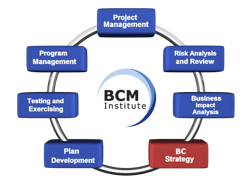[P2] Finalising Your Business Continuity Strategy & Obtain Acceptance
This is Part 2 of the Business Continuity Strategy (BCS) reporting to executive management.
This section is part of the BCM-5000 Module 3 Pre-reading List. It is preparing to compile and present the BCS Strategy report to Executive Management.

When you complete the BCM-5000 Module 2, you have the competency of a BU BCM Coordinator as you have completed the BCS Questionnaires.
You have also understood the objectives and challenges of achieving the BC Strategy Questionnaires at the business unit level.
In Modules 3 and 4, you assume the role of an Organisation BCM Coordinator. You must analyse and present the BC Strategy findings as a report to Executive Management for approval.
The content is extracted from the BCM Planning Series: Developing Recovery Strategy for Your Business Continuity Plan.
Finalise Strategy
Develop the BC Strategy Report
 This is the final step of the BC Strategy process. By this stage, you will be very familiar with the organisation's overall operations.
This is the final step of the BC Strategy process. By this stage, you will be very familiar with the organisation's overall operations.
However, you should remember that others who read your report may not benefit from such experience or knowledge.
This is especially true for those reading it for the first time since the start of the BC Strategy phase.
Keep these steps in mind when you are developing your final report:
- Issue a draft report to participating business unit managers and request their feedback
- Review the feedback
- Revise the findings or add to outstanding issues
- Schedule a workshop or meeting with participating business unit managers to discuss initial findings, if necessary
- Update original findings to reflect changes arising from meetings
- Prepare the final recovery strategy report according to organizational standards
- Make a formal presentation of the findings to the Executive Management
Rationalisation and Critique of the Report
 I always recommend submitting a draft BC Strategy report to the Organization BCM Coordinator, which usually consists of business unit representatives and the project sponsor, for their comments and ratification.
I always recommend submitting a draft BC Strategy report to the Organization BCM Coordinator, which usually consists of business unit representatives and the project sponsor, for their comments and ratification.
There is nearly always a need for someone to critique and rationalize the business unit’s content. For example, the procurement unit may insist on recovering fifty per cent of their staff member strength within three days, but the Executive Management may feel differently.
As the Organization BCM Coordinator, you can suggest that the requirement seems unrealistic. Still, if the BU BCM Coordinator or even the Head of BU insists, you have to include their input, hence the importance of rationalization.
Prepare the BC Strategy Report
The report should include background information to help all parties reach a common understanding. It must also be clearly written to avoid attracting unnecessary and irrelevant questions.
The report may be structured as follows:
- Why was the BC Strategy conducted?
- What were the objectives set?
- What was the scope of the exercise?
- What was the approach used?
- What are the required resources?
- What were the detailed findings?
- What were the conclusions?
- What were the strengths and weaknesses?
- What are the recommendations to Executive Management?
Following this methodology will undoubtedly produce a lengthy and detailed report, mainly if you include graphs, tables and diagrams. However, very few people need to read the report in its entirety.
You should have an executive summary for management containing the introduction, conclusions and significant recommendations. There should also be individual sections for business unit managers, proposals for quality assurance staff, and those responsible for business continuity.
It is crucial to make sure that the BC Strategy report is a complete document that is sufficiently detailed, it is sensitive to the passage of time, and it highlights the following:
- What is the recovery strategy?
- Where is the most important impact of an incident?
- What is the current level of preparedness?
- What improvement must be made to the working practices during a normal situation and an emergency?
When your BC Strategy report is completed, you will have a blueprint for the entire organisation's recovery and continuity of functions.
Obtain Management Approval
Since this program is a top-bottom approach, it is vital to meet the expectations of the executive management. The report then needs to describe:
- What is the key problem?
- What is the current state of the solution?
- What is required from them?
The executive management members often do not realise that they can only authorize using resources for the BCM planning process. The Executive Management will, therefore, need to know the following:
- What is required?
- Why is it required?
- When is it required?
- How much will it cost?
 I recommend that your BC Strategy report be around three to four pages long as a guide.
I recommend that your BC Strategy report be around three to four pages long as a guide.
The report should include a detailed summary of the recovery strategies. It would typically be around twenty pages long.
The Executive Management members are likely to read only the executive summary, which should include a concise set of recommendations and, if appropriate, a cost implementation plan.
A sample BC Strategy Report can be viewed during the training session.
Content of Presentation
The presentation to Executive Management should not exceed twenty minutes, if possible. The goals of the presentation are:
- Provide information about the impact of disruption on the organization
- Obtain acceptance of the findings of the BC strategy report
- Seek approval on the direction of plan development implementation
- Build a case for developing a business continuity management program
Presentation to Management
The management presentation should focus on the overall recovery strategy for all critical business functions. The analysis results should be presented in a table or graph.
The methodology used, sources of the information, and textual explanations of the results should be presented concisely.
After the results are presented, the BCP Project Manager should state the priorities assigned to business units.
After the management presentation, the BCM Project Manager should explain how the recovery strategy results would be used to implement the strategies and infrastructural enhancement.
Approval of Report
The final step of documenting the Executive Management decision is often missing. The BCP Project Manager should extract the “minutes of the meeting” and file the recorded minutes highlighting the recovery strategy approval. Internal and external auditors often review this document.
 Proceed to the Next Step
Proceed to the Next Step
To proceed to the following process, which is the plan development phase, you may need to read the next book, “Implementing Your Business Continuity Plan.”
More Information About Business Continuity Management Courses
To learn more about the course and schedule, click the buttons below for the BCM-300 Business Continuity Management Implementer [BCM-3] and the BCM-5000 Business Continuity Management Expert Implementer [BCM-5].




![Register [BL-B-3]*](https://no-cache.hubspot.com/cta/default/3893111/ac6cf073-4cdd-4541-91ed-889f731d5076.png)



![FAQ [BL-B-3]](https://no-cache.hubspot.com/cta/default/3893111/b3824ba1-7aa1-4eb6-bef8-94f57121c5ae.png)
![Email to Sales Team [BCM Institute]](https://no-cache.hubspot.com/cta/default/3893111/3c53daeb-2836-4843-b0e0-645baee2ab9e.png)





